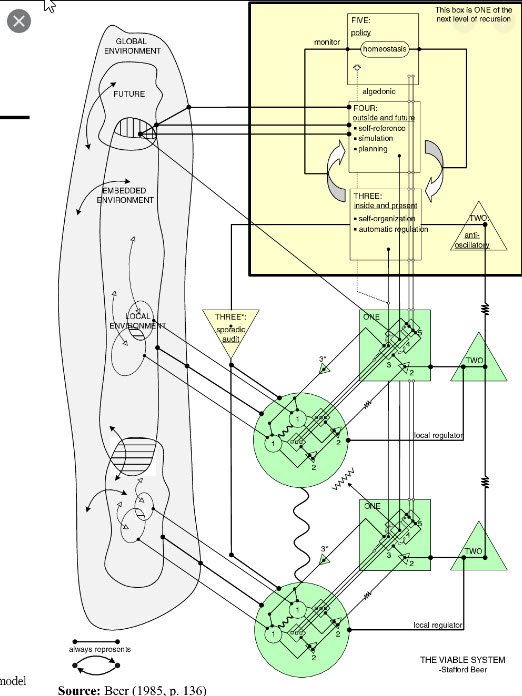I’m not getting the connection between slides 37, 38 and 39 and Beer’s Viable Systems Model. Maybe a small part of it. All 5 systems of VSM repeat at all levels. Most attempts to diagram it are hopelessly convoluted and usually rather wrong. Here’s one by Beer that’s almost comprehensible.
Gene:
Thanks for the feedback. I agree about the complexity of the
VMS.
Do you argee that the VSM just consists of chunks of functionality and their relationships?
And would you agree that the labels of the chunks vary depending upon the system being modeled?
And that Each line represents: a type of relationship (what type depends on which line in the model it is).
From my understanding the types of relationships are information, material, and energy?
Tony
Everything consist of chunks of functionality and their relationships.
The labels for VSM are always System 1 though System 5
As for types of relationships what’s the difference between material and energy? There are relationships which deplete the source and those that don’t.
Gene said: Everything consist of chunks of functionality and their relationships.
I agree. Add an overriding goal and we have a system.
Gene said: The labels for VSM are always System 1 though System 5
This counters my understanding. I will have to do some more digging. If the labels for the chunks are always System 1 through 5, then how do we know the goals per chunk are?
.
Material is like raw materials and inventory. Energy can take many forms including heat, light, and electrical. Each of these can be an input to a process just as much as information can.
Regarding your comment that “There are relationships which deplete the source and those that don’t.”
I can see your point here, but I tend to see relationships, for activity-centric models as input and outputs
Tony, I went though the presentation and I think you might fare better having someone else looking at it. I just no longer dwell in the mire. It takes far too long to try to get people to understand it and they really don’t care to anyway. Just work with them to build stories that are meaningful to them and enable them to realize how smart they already are… and stop making them feel stupid.
Gene:
When I work with the user community I use stories. The presentation is for presenting the concepts of systems thinking - a different audience. I am not making people feel stupid.
You say you’re not making people feel stupid, how would you know? And how would you put the presentation together as a story?
What’s your thought after you watch the video at…
Gene:
The question you pose towards the end of the Moments video is “What is the [overriding] problem?” We have problem in achieving our underlying aim (i.e., underlying basis per Ackoff). I can not figure out what the overall aim for the underlying system in the example is. Can you tell me what it is?
On make people comfortable: There have been studies as to how complex of a data flow diagram people can comfortably handle. Answer: 5 to 7 activities per diagram max. I have always experienced such. After that breaking the diagrams down further is needed.
Regarding your question on putting the presentation together, what presentation are you referring to?
I think I have my discussion threads crossed as it seems it was someone else’s presentation.
As for Moments… the underlying problem is not thinking of the implications of our actions before we take them. In that particular situation had I considered all the implication of the action I was about to take I probably wouldn’t have taken it.
Implication of your action in terms of your aim. I have yet to see a CLD in which the overall aim was evident.
The aim was to help me have a more pleasant breakfast and as such be in a better position to deal with my ongoing daily frustrations.
I thought Gene was talking about this presentation:
Ok, I will now revisit your question “What is the [overriding] problem?” But, tomorrow. (Got an appointment in 10 min.)
Oh that… I had it in a state where I could easily walk through it with high school grads. But I have been expanding the scope to include additional concepts and it needs rework.
Yes, I was though it seems I’m often confused as to what I’m referring to…
Gene:
Regarding the Moments video’s question “What is the problem?”
I previously posted that I was going to revisit this based upon your statement of the system’s Aim. However, I did not see at the time that you already answered the question so I will drop it.
Yes. One of my favorites is this: Solve Everything at Once: Nora Bateson on systems thinking, warm data & singing out loud

Thanks for the info.
What is remarkable about Nora Bateson, the daughter of Gregory Bateson, that she is practicing not only systems thinking but systems being.
In an earlier post, where Pete has called our attention to her work, we can read about her research focus epitomized by this question:
“How can we create a context in which to study the contexts?”
Wouldn’t that question mesh well with what OGM could do if we were to support to the transformative movements working for reimagining and redesigning our institutions and social sectors (each of which is an interdependent context for the other)?
FYI: Nora is not only theorizing about all this but also, has developed the Warm Data Lab methodology, in which she is remaining people. (Disclosure: I’m a certified WDL facilitator.)

